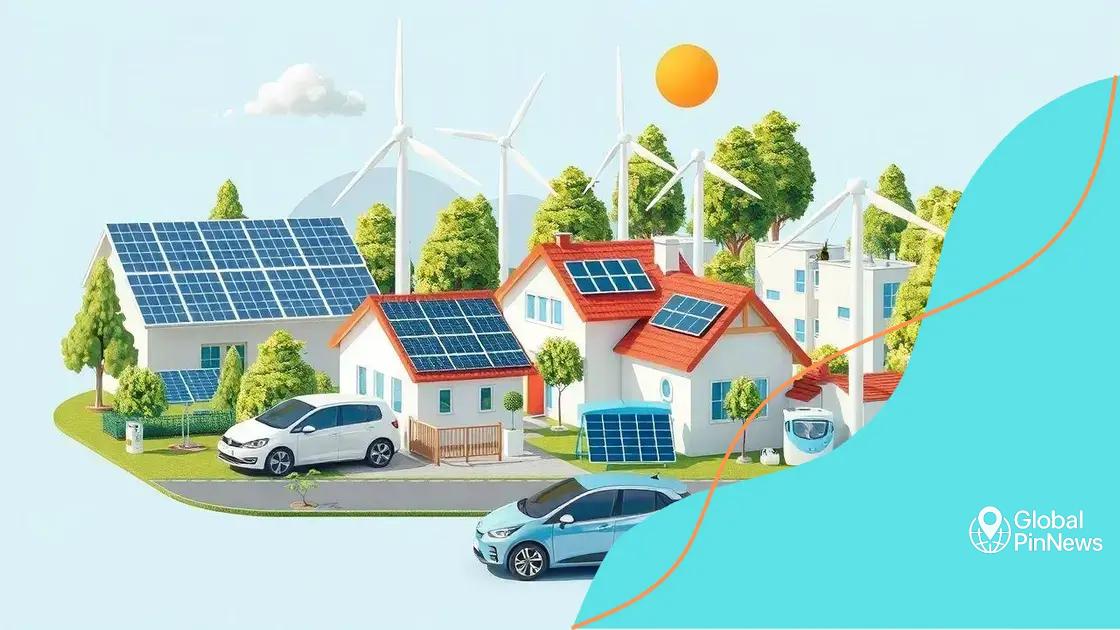Environmental protection initiatives progress: what’s the latest?

Environmental protection initiatives progress involves community engagement, innovative technologies, effective government policies, and successful case studies that collectively promote sustainability and address climate change challenges.
Environmental protection initiatives progress is vital in our fight against climate change. Have you ever wondered what steps are being taken to secure a sustainable future? Let’s delve into the latest efforts that are making a real difference.
Recent advancements in environmental protection
In recent years, advancements in environmental protection have gained significant attention. With more people understanding the impact of climate change, various innovations and initiatives have emerged to combat these challenges. Efforts to promote sustainability are crucial, as they not only protect our planet but also foster healthier communities.
Technological Innovations
One of the key areas of progress is the development of green technologies. These range from renewable energy sources like solar and wind power to breakthroughs in energy efficiency.
- Solar panels that are more affordable and efficient.
- Advanced wind turbines capable of generating more electricity.
- Smart grids that optimize energy distribution.
Such technologies play a vital role in reducing our carbon footprint and dependency on fossil fuels. As we continue to innovate, the potential to increase energy access while preserving the environment becomes greater.
Community Action
On the community level, grassroots movements have proven effective in driving local change. Citizens are coming together to implement solutions that benefit their surroundings.
- Urban gardens that promote biodiversity.
- Recycling programs minimizing waste.
- Community clean-up events boosting local engagement.
These grassroots efforts highlight the importance of local action in supporting global initiatives. By working together, communities can make lasting impacts on their environment.
Collaborations between governments and non-profit organizations are also essential. They offer funding and resources for innovative projects focused on conservation and sustainability. These partnerships allow for sharing knowledge and best practices across regions.
Policy Changes
Policy changes have significantly influenced the direction of environmental protection. New regulations are aimed at reducing emissions and promoting sustainable practices.
- Carbon pricing to encourage lower emissions.
- Stricter regulations on plastic production.
- Incentives for companies adopting sustainable practices.
Such policies motivate businesses and individuals to prioritize the environment. As these advancements continue, it’s evident that a collaborative effort is essential for meaningful progress.
Community engagement in environmental initiatives
Community engagement in environmental initiatives is crucial for creating sustainable solutions. When individuals come together, they can drive meaningful change. Local efforts often serve as a foundation for larger environmental movements.
Importance of Local Action
Engaging communities helps to raise awareness about environmental issues. Local workshops and events educate residents on how they can contribute. This involvement leads to a shared commitment to protect the environment.
- Workshops on recycling and waste reduction.
- Neighborhood clean-up days to beautify public spaces.
- Tree planting events to enhance local biodiversity.
Through these activities, communities create connections while fostering a sense of responsibility towards their surroundings.
Building Partnerships
Collaboration is another essential aspect of community engagement. When local governments partner with residents, they can pool resources to tackle environmental challenges more effectively. These partnerships often lead to projects that benefit both the environment and the community.
- Community gardens that provide fresh produce.
- Public transportation initiatives that reduce carbon emissions.
- Collaborative recycling programs that minimize waste.
Such collaborations empower residents, making them feel valued in the decision-making process. This strengthens their commitment to participate in ongoing initiatives.
Moreover, social media plays a vital role in spreading awareness. Local groups can share events and encouraging stories, leading to higher participation rates. Engaging platforms connect like-minded individuals, fostering a supportive community dedicated to environmental protection.
Success Stories
Many communities showcase successful engagements that have made significant impacts. These stories inspire others to follow suit and take action. By highlighting achievements, residents can motivate each other to join in.
- Successful urban composting programs that reduce food waste.
- Community-led beach clean-ups that promote marine conservation.
- Local advocacy for policy changes that protect green spaces.
With every effort, communities contribute to the broader movement for a healthier planet. Their dedication and passion can lead to lasting environmental change.
Technological innovations supporting sustainability

Technological innovations supporting sustainability are transforming how we interact with our environment. From renewable energy sources to smart technologies, these advancements enhance efficiency and reduce our ecological footprint.
Renewable Energy Technologies
One significant advancement in sustainability is the rise of renewable energy. Solar, wind, and hydroelectric power are becoming more accessible and efficient. With decreasing costs and improved technology, these energy sources are now viable alternatives to fossil fuels.
- Solar panels with higher energy conversion rates.
- Wind turbines designed for efficiency in low-wind areas.
- Hydropower systems that are less disruptive to ecosystems.
These innovations not only lower greenhouse gas emissions but also promote energy independence.
Smart Technologies
Smart technologies are also at the forefront of supporting sustainability. By utilizing data and connectivity, they help optimize resource use and minimize waste. For instance, smart grids allow for more effective energy distribution.
- Home energy management systems that monitor usage.
- Smart irrigation systems that conserve water.
- Automated waste sorting technology that increases recycling rates.
These technologies empower individuals and organizations to make informed choices, leading to more sustainable practices.
Additionally, electric vehicles (EVs) are revolutionizing transportation. As infrastructure improves, EVs become more prevalent, reducing reliance on gasoline and decreasing air pollution. Charging stations are being integrated into public spaces, making it easier for people to switch to cleaner alternatives.
Innovative Materials
Another area of technological progress involves the development of innovative materials focusing on sustainability. Biodegradable plastics and materials sourced from renewable resources are emerging trends.
- Bioplastics derived from corn or sugarcane.
- Recycled materials used in manufacturing.
- Eco-friendly building materials that save energy.
These materials contribute to a circular economy, reducing waste and conserving natural resources.
As we continue to embrace technological innovations, it is essential to support research and development that prioritizes environmental health. Such advancements pave the way for a more sustainable future, ensuring that we meet our needs without compromising the planet for future generations.
Government policies impacting environmental progress
Government policies impacting environmental progress play a critical role in shaping how societies address ecological challenges. Through effective legislation and regulation, governments can foster initiatives that promote sustainability and protect natural resources.
Environmental Regulations
Environmental regulations are established to limit pollution and reduce environmental harm. These laws compel industries to adopt cleaner practices.
- Regulations that set limits on emissions from factories.
- Laws requiring companies to disclose their environmental impact.
- Standards for waste management to encourage recycling.
Such regulations not only protect the environment but also encourage innovation as companies seek more sustainable alternatives.
Incentives for Sustainable Practices
Governments also implement incentives to promote sustainable practices. Tax credits and grants can motivate businesses and individuals to invest in green technologies.
- Subsidies for renewable energy projects.
- Tax reductions for electric vehicle purchases.
- Funding for energy-efficient home renovations.
These incentives lower financial barriers and help shift public behavior towards sustainability.
Moreover, public awareness campaigns funded by the government can educate citizens about environmental issues. By providing information on conservation and sustainable living, these efforts empower individuals to take action in their communities.
International Agreements
International agreements also influence domestic policies related to the environment. Agreements like the Paris Accord set global standards that countries commit to achieving.
- Targets for reducing greenhouse gas emissions.
- Commitments to enhance renewable energy sources.
- Collaboration on biodiversity conservation efforts.
Participating in such agreements helps countries align their environmental goals with global needs, fostering a collaborative approach to tackling climate change.
As these government policies evolve, they create a framework that guides the direction of environmental progress. By prioritizing sustainable practices, governments can lead the way towards a healthier planet.
Case studies of successful environmental projects
Case studies of successful environmental projects showcase the potential of innovative ideas to create positive change. These examples provide insight into how communities and organizations can work together to tackle environmental challenges.
Urban Forests in New York City
One inspiring example is the urban forest initiative in New York City. An effort to increase green space, this project involves planting trees in city neighborhoods. Since its launch, it has significantly improved air quality and provided shade for residents.
- Over 100,000 trees have been planted.
- Community volunteers participate in planting and maintenance.
- Research shows a reduction in city temperatures.
This project has fostered a sense of community while promoting biodiversity in an urban setting.
Plastic Waste Reduction in Nairobi
Another notable case is Nairobi’s initiative to reduce plastic waste. The city implemented a ban on plastic bags, encouraging residents to adopt more sustainable alternatives.
- Reusable shopping bags are now widely used.
- Local businesses support eco-friendly packaging solutions.
- Community education programs raise awareness about plastic pollution.
This effort has led to cleaner streets and a decrease in pollution, demonstrating community commitment to environmental stewardship.
Water Conservation in Cape Town
During a severe drought, Cape Town launched a successful water conservation campaign known as “Save Water.” The initiative encouraged residents to reduce their water usage through various strategies.
- Public engagement through social media campaigns.
- Incentives for installing water-saving devices.
- Community workshops on sustainable gardening practices.
This campaign not only helped the city cope with the water crisis but also fostered a culture of conservation that continues today.
These case studies highlight how collaboration and innovative strategies can lead to successful environmental projects. By learning from these examples, other communities can be inspired to undertake their own initiatives for positive environmental impact.
FAQ – Frequently Asked Questions about Environmental Protection Initiatives
What are some successful examples of community environmental projects?
Successful examples include urban tree planting in New York City, a plastic waste reduction initiative in Nairobi, and water conservation efforts in Cape Town.
How do government policies affect environmental sustainability?
Government policies create regulations and incentives that promote eco-friendly practices, helping to reduce pollution and encourage sustainable innovation.
Why is community engagement important in environmental initiatives?
Community engagement fosters collaboration, raises awareness, and mobilizes local resources, leading to more impactful and sustainable environmental actions.
What are technological innovations supporting sustainability?
Technological innovations include renewable energy solutions, smart technologies for energy efficiency, and the development of sustainable materials that reduce waste.
